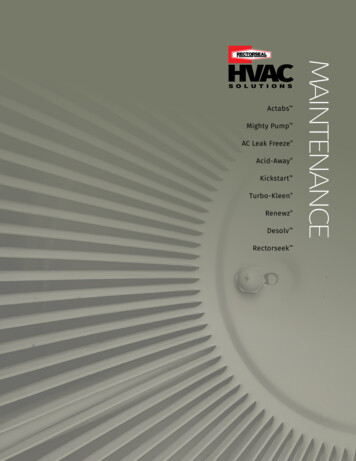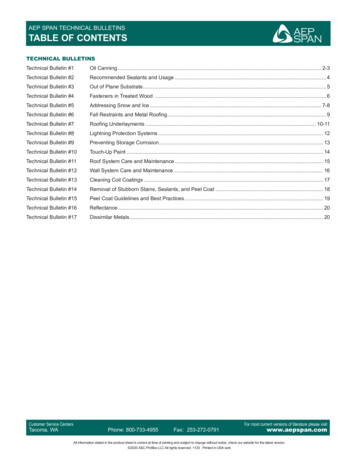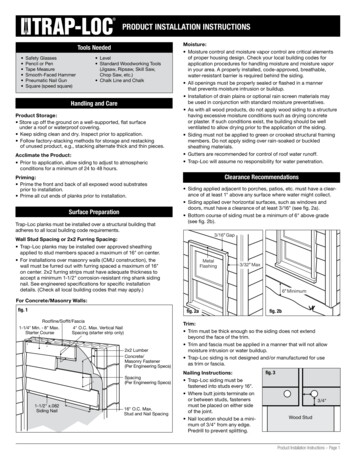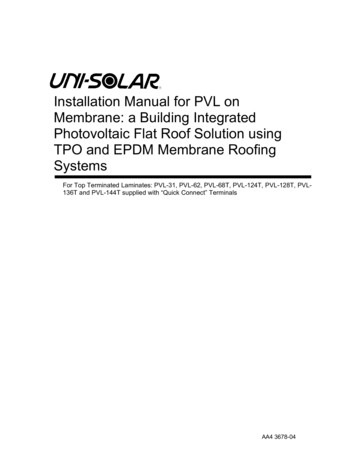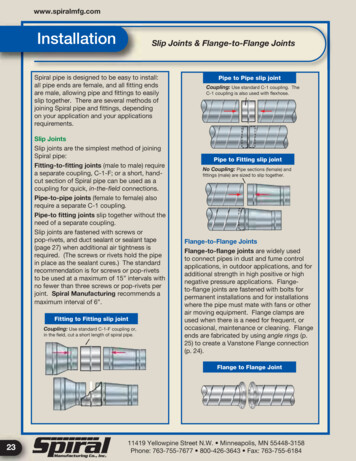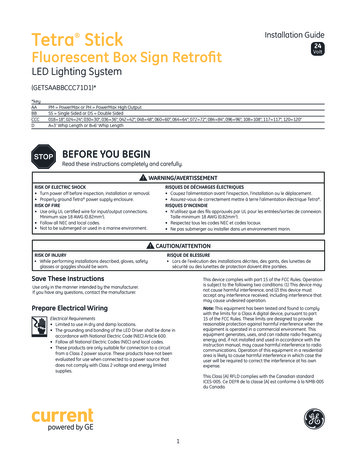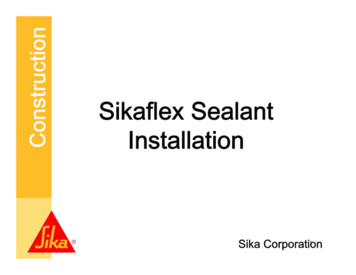
Transcription
Sikaflex SealantInstallation1Sika Corporation
Critical Success FactorsSubstrate preparation If done properly would probably eliminate 95% of allcall backs– Most common mode of sealant failure Must remove all weak material on bonding surface ofporous substrates Surfaces must be clean, dry, free of dew or frost Use best practices as recommended by industryexperts:– Porous: abrasive, high pressure water (allow surface to dry),grinding, wire brush, compressed air (oil free)– Non-porous: 2 rag method (clean, lint-free, and absorbent solvent wipe followed by an immediate dry cloth wipe. Donot spread contaminants)2Sika Corporation
Mechanical Methods Wire brushingSand blastingGrindingSawing3Sika Corporation
Mechanical MethodsSaw cut joint – to provideproper width & sound jointinterface.4Sika Corporation
Mechanical MethodsSandblast to removeresidues & provide profile5Sika Corporation
Critical Success FactorsPriming Priming can help get abetter bond in manysituations– Priming does notsubstitute for good prep– Many products performw/out primers– Most commonly used onhorizontal andsubmerged applications– Must be done properlyto work (primers are noterror free: ponding,waiting time, etc.)– Sikaflex primer aresubstrate specificProper primer application with brushPrime only sides of the joint.Primer outside the joint may stain the substrate.Prime & seal the same day6Sika Corporation
Critical Success FactorsPriming7Sika Corporation
Critical Success FactorsBacking materials Why use backer rod:– Attain proper wettingof substrate whensealant is tooled– Control sealant depth ½” maximum– Prevent 3-sidedadhesion– Provide support fortraffic areas8Sika Corporation
Critical Success FactorsBacking materials Recommended Materials– Closed cell backer rod: primarily a foammaterial with a surface skin– Open cell backer rod: primarily a foam materialwithout a skin– Bicellular backer rod: sometimes called “soft”rod, this foam acts like a hybrid between openand closed cell rods– Bond Breaker Tape or Backing Tape: primarilya self-adhesive polyethylene or Teflon material– Hard rectangular extrusions for horizontals9Sika Corporation
Sealant InstallationBacking Materials10Sika Corporation
Sealant InstallationBacking Materials Make sure backer rodis 25% larger thanjoint width (undercompression) to offergood tooling base No not punctureclosed cell backer rodwhen installing prior tosealant installation– Will cause bubbling insealant11Sika Corporation
Critical Success FactorsBacking materials Joint Interface – the sides of the jointwhere the sealant is adhered. Three-sided Adhesion – where thesealant is adhered to the sides of thejoint as well as the bottom of the joint.123JointinterfaceUse BondBreaker Tape12Sika Corporation
Critical Success FactorsBacking materialsWhere the depth willnot permit the use of abacker rod apolyethylene bondbreaker tape may beused.13Sika Corporation
Joint without bond breaker tapeCourtesy Sika14Sika Corporation
Sealant InstallationLoading Cartridge– Cut cartridge tip andpuncture seal at thenozzle base– Load cartridge intocaulk gun Sausage– Load sausage intosausage gun, then cutthe metal clip off– Attach nozzle15Sika Corporation
Sealant Installation GunningPlace nozzle of gun into thebottom of thejoint and fill the entire joint Keeping nozzle deep in thesealant, continue asteady flow of sealantpreceding the nozzle toavoid air entrapment Avoid overlappingsealant Coverage:– 10.1 fl oz yields 12.2 linear feetof ½” x ¼” joint– 20 fl oz uni-pac yields 24 linear ftof a ½ “ x ¼“ joint16Sika Corporation
Sealant InstallationMixing Open pail of Sikaflex 2c and remove “B”component17Sika Corporation
Sealant InstallationMixingPour entire contentsof “B” componentinto pail of component“A” Add entire contentsof color pak into pailif using tint base 18Sika Corporation
Sealant InstallationMixing A cold weather booster can be added tospeed up tack free time19Sika Corporation
Sealant InstallationMixingSealant Mixing Paddles Mix with a lowspeed drill (400-600rpm) and a sealantmixing paddle. Mix for 3-5 minutes toachieve a properconsistency anduniform color Avoid entrapment ofair during mixing20Sika Corporation
Sealant InstallationMixing Scrape downthe sides of thepailperiodically toensure all of thematerial isproperly mixed.21Sika Corporation
Sealant InstallationLoading Load sealant into a bulk sealantgun directly or use a follower plate system22Sika Corporation
Sealant InstallationGunning Place nozzle of gun into the bottom of thejoint and fill the entire joint23Sika Corporation
Sealant InstallationGunning Keeping nozzledeep in the sealant,continue a steadyflow of sealantpreceding the nozzleto avoid air entrapment Avoid overlappingsealant Coverage:– 1 gallon yields 231cubic inches or 154linear feet of ½” x ¼”joint24Sika Corporation
Sealant InstallationGunningWhen neatnesscounts always tapeoff the sides of thejoint using DuctTape.(Remove tapeimmediately aftergunning and toolingsealant)25Sika Corporation
Sealant InstallationGunningHorizontal applicationsrequire excellentadhesion toconcrete and selfleveling option forflat work. Sealantmust handlespecified trafficconditions.26Sika Corporation
Sealant InstallationTooling Dry tool sealant to press materialagainst joint walls or bonding surface– Never use alcohol or other solvents to tool apolyurethane sealant27Sika Corporation
Sealant InstallationJoint DesignMax depth ½”Min depth ¼”Depth ½ Width2:1 width to depth rationSealantBacker rod1. Install appropriate backer material to prevent three-sided adhesion and to controlsealant depth.2. Sealant should be gunned into joint at mid-point of designed expansion andcontraction to maximize accommodation of movement. Joint dimension of 4Xanticipated movement allows proper function of high performance sealants even ifapplied at temperature extremes.3. Tool as required to properly fill joints and force sealant against joint interfaces,maximizing bond.28Sika Corporation
Adhesion Testing Always test foradhesion Jobsite Pull Test:After material hascured to ensureproper bond Test actual substrateson site Document locationsand times29Sika Corporation
Jobsite Pull TestPlace sealant andallow to cure. Cuta 2-3” piece of thesealant and pull ata 90º angle fromthe substrate.The sealantshould not “peel”from the jointinterface.30Sika Corporation
Sikaflex Sealant InstallationTo take the Sikaflex Sealant InstallationCertification Test click here:Sealant Installation Certification Test31Sika Corporation
Closed cell backer rod: primarily a foam material with a surface skin - Open cell backer rod: primarily a foam material without a skin - Bicellular backer rod: sometimes called "soft" rod, this foam acts like a hybrid between open and closed cell rods - Bond Breaker Tape or Backing Tape: primarily a self-adhesive polyethylene or .



